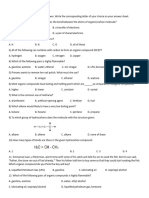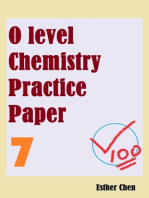Tamilnadu 12th Chemistry Lesson 11 - One Marks: Choose The Correct Answer
Tamilnadu 12th Chemistry Lesson 11 - One Marks: Choose The Correct Answer
Uploaded by
M05059 Kaushik S XI AOriginal Description:
Original Title
Copyright
Available Formats
Share this document
Did you find this document useful?
Is this content inappropriate?
Report this DocumentCopyright:
Available Formats
Tamilnadu 12th Chemistry Lesson 11 - One Marks: Choose The Correct Answer
Tamilnadu 12th Chemistry Lesson 11 - One Marks: Choose The Correct Answer
Uploaded by
M05059 Kaushik S XI ACopyright:
Available Formats
www.usefuldesk.
com
Tamilnadu 12th Chemistry Lesson 11 – One Marks
Choose the correct answer:
1.
Which of the following compounds on reaction with methyl magnesium bromide will give
tertiary alcohol?
A. Benzaldehyde
B. Propanoic acid
C. Methyl propanoate
D. Acetaldehyde
ANSWER: C
2.
Which one of the following is the strongest acid
A. 2 - nitrophenol
B. 3 - nitrophenol
C. 4 - nitrophenol
D. 6 - nitrophenol
ANSWER: C
3.
Carbolic acid is ______
A. Phenol
B. Picric acid
C. Benzoic acid
D. Phenylacetic acid
ANSWER: A
4.
Which of the following compound can be used as antifreeze in automobile radiators?
A. Methanol
B. Ethanol
C. Neopentyl alcohol
D. Ethan – 1,2 diol
ANSWER: D
5.
On reacting with neutral ferric chloride, phenol gives
A. Red colour
B. Violet colour
C. Dark green colour
D. No colouration
ANSWER: B
Additional One Word:
1.
Which one of the alcohol cannot be prepared by Grignard reagent?
Website: www.usefuldesk.comFacebook: www.facebook.com/usefuldeskE-mail: info@usefuldesk.com
www.usefuldesk.com
A. Methanol
B. Ethanol
C. Alcohol
D. Phenyl
ANSWER: A
2.
Which is optically active?
A. n – butyl alcohol
B. isobutyl alcohol
C. 2 butanol
D. t butyl alcohol
ANSWER: C
3.
Glycerol is used
A. As a sweetening agent
B. In the manufacture of good quality soap
C. In the manufacture of nitro glycerin
D. In all the above
ANSWER: D
4.
When phenol is distilled with zinc dust it gives
A. Benzaldehyde
B. Benzoic acid
C. Toluene
D. Benzene
ANSWER: D
5.
Intermolecular hydrogen bonding in ethylene glycol leads to its
A. High viscosity
B. High boiling point
C. Hydroscopic nature
D. All the above
ANSWER: D
6.
Alcohols are isomeric with
A. Aldehyde
B. Ketones
C. Ethers
D. Esters
ANSWER: C
7.
Higher alcohols are not soluble in water because of
Website: www.usefuldesk.comFacebook: www.facebook.com/usefuldeskE-mail: info@usefuldesk.com
www.usefuldesk.com
A. Hydrophilic alkyl group
B. Hydrophobic alkyl groups
C. Hydrophilic aryl group
D. Hydrophobic aryl groups
ANSWER: B
8.
With concentrated sulphuric acid, glycol undergoes intermolecular dehydration to give cyclic
compound.
A. Diethylene glycol
B. Dioxan
C. Paraldehyde
D. Glyoxal
ANSWER: B
9.
Which of the following gives violet colour with neutral ferric chloride solution?
A. Phenol
B. Glycerine
C. Benzyl alcohol
D. Ethanol
ANSWER: A
10.
Which among the following has both local anaesthetic and antiseptic properties?
A. Benzyl benzoate
B. Phenol
C. Benzyl alcohol
D. n – propyl alcohol
ANSWER: C
11.
Which of the following has an offensive odour?
A. Phenol
B. Benzyl alcohol
C. Acrolein
D. Benzyl benzoate
ANSWER: C
12.
Secondary alcohol on oxidation gives
A. Aldehyde
B. Ketone
C. Ester
D. Anhydride
ANSWER: B
Website: www.usefuldesk.comFacebook: www.facebook.com/usefuldeskE-mail: info@usefuldesk.com
www.usefuldesk.com
13.
The compound that does not undergo cannizaro reaction is
A. Formaldehyde
B. Acetaldehyde
C. Benzaldehyde
D. Trimethyl
ANSWER: B
14.
The compound that acts as a solvent for Grignard reagent is
A. Ethyl alcohol
B. Diethyl ether
C. Acetone
D. Benzene
ANSWER: B
Fill in the Blanks:
1.
The major product obtained when phenol is treated with sodium hydroxide and carbon di
oxide is _______
A. Salicyaldehyde
B. Salicyclic acid
ANSWER: B
2.
The ether used in perfumery is ______
A. Methyl phenyl ether
B. Diphenyl ether
ANSWER: A
3.
The number of secondary alcoholic group in glycerol is ______
A.1
B.2
ANSWER: A
4.
The boiling point of ethyl alcohol should be less than that of _____
A. Propane
B. Formic acid
ANSWER: B
5.
A compound that gives a positive iodoform test is _______
A. 2 - Pentanol
B. 1 - Pentanol
ANSWER: A
6.
Website: www.usefuldesk.comFacebook: www.facebook.com/usefuldeskE-mail: info@usefuldesk.com
www.usefuldesk.com
A compound that undergoes bromination easily is _______
A. Phenol
B. Benzoic acid
ANSWER: A
7.
Isomerism exhibited by ethylene glycol is _____
A. Chain isomerism
B. Functional isomerism
ANSWER: B
8.
The alcohol obtained by the hydrolysis of oils and fats is ______
A. Glycerol
B. Pentanol
ANSWER: A
9.
The active component of dynamite is ________
A. Nitro benzene
B. Nitro glycerine
ANSWER: B
10.
The characteristic odour of lower phenol is _____
A. carbolic acid
B. Fruity
ANSWER: A
11.
Phenol is used to manufacture ______
A. Plastics and drugs
B. Fruity
ANSWER: A
12.
_______ is used as an antifreeze in automobiles radiators.
A. Methanol
B. Ethanol
ANSWER: A
13.
The number of primary alcoholic groups in ethylene glycol is ____
A. 1
B. 2
ANSWER: B
14.
The ultimate product obtained when glycerol reacts with oxalic acid at 533K is _____
A. formic acid
Website: www.usefuldesk.comFacebook: www.facebook.com/usefuldeskE-mail: info@usefuldesk.com
www.usefuldesk.com
B. Allyl alcohol
ANSWER: B
15.
Phenol turns ______ when air oxidised.
A. Red
B. Violet
ANSWER: A
16.
The common name for 4 – hydroxyl toluene is _____
A. q - cresol
B. p - cresol
ANSWER: B
17.
Ethanol and methoxy methane are _______
A. Functional isomers
B. Chain isomers
ANSWER: A
18.
Oxidation of glycerol with bismuth nitrate gives ______
A. Meso oxalic acid
B. Tartronic acid
ANSWER: A
19.
The characteristic odour of lower phenols is ____
A. Rotten fish
B. Carbolic acid
ANSWER: B
20.
Oxygen atom of ether is ____
A. Comparatively inert
B. Very active
ANSWER: A
21.
When ethyl iodide is treated with dry silver oxide it forms _____
A. Diethylether
B. Silver ethoxide
ANSWER: A
22.
When ether is exposed to air for sometime an explosive substance produced is _____
A. TNT
B. Peroxide
ANSWER: B
Website: www.usefuldesk.comFacebook: www.facebook.com/usefuldeskE-mail: info@usefuldesk.com
www.usefuldesk.com
23.
Metamerism is exhibited by ______
A. Ether
B. Mineral acid
ANSWER: A
24.
1 – Methoxy propane and 2 – methoxy propane are _____
A. Chain isomers
B. Metamers
ANSWER: B
25.
Ethers are functional isomers of ______
A. Acids
B. Alcohols
ANSWER: B
26.
Lower halogenated ethers can be converted into higher ethers by using _______ reagent.
A. Grignard
B. Tollens
ANSWER: A
27.
Ether oxygen is capable of forming ______ bonds with electron deficient species.
A. Ionic
B. Coordinate covalent
ANSWER: B
28.
On heating, peroxides are _____
A. Unstable and decomposes violently
B. Stable
ANSWER: A
29.
The IUPAC name of phenetole is _______
A. Ethoxybenzene
B. Diethyl ether
ANSWER: A
Website: www.usefuldesk.comFacebook: www.facebook.com/usefuldeskE-mail: info@usefuldesk.com
You might also like
- ZIMSEC Form 2 End of Term 1 Exam Paper 1 and Paper 2 Questions Combined Science Set 1Document8 pagesZIMSEC Form 2 End of Term 1 Exam Paper 1 and Paper 2 Questions Combined Science Set 1Kudakwashe MusvaireNo ratings yet
- Gemstone Cutting & PolishingDocument95 pagesGemstone Cutting & Polishingsoothsayer144100% (1)
- Class - 12 Chemistry Neet Test - No.2Document6 pagesClass - 12 Chemistry Neet Test - No.2S. Sunil KumarNo ratings yet
- Lahore Grammar College Test Session (2020-2021)Document2 pagesLahore Grammar College Test Session (2020-2021)ABDULLAH BIN AFZAALNo ratings yet
- Pre TEST in Carbon Compounds - ResearchDocument3 pagesPre TEST in Carbon Compounds - ResearchCYRIL CONSTANTINONo ratings yet
- Midterm Examination Organic ChemistryDocument4 pagesMidterm Examination Organic ChemistryMichael Padilla Esmalla100% (1)
- POST TEST in Carbon Compounds - ResearchDocument3 pagesPOST TEST in Carbon Compounds - ResearchCYRIL CONSTANTINONo ratings yet
- Multiple Choice Questions Unit Chem-100Document2 pagesMultiple Choice Questions Unit Chem-100FernandaIbarraVázquezNo ratings yet
- 04-W-4 ChemistryDocument9 pages04-W-4 Chemistryzain IshaqNo ratings yet
- 8 - QP - Aldehyde Ketone Carboxylic AcidDocument8 pages8 - QP - Aldehyde Ketone Carboxylic AcidJems Chaudhary100% (1)
- Alcohols, Phenols and Ethers - PYQ Chemistry Class 12 PDF DownloadDocument10 pagesAlcohols, Phenols and Ethers - PYQ Chemistry Class 12 PDF DownloadamreshNo ratings yet
- AminesDocument8 pagesAminesryanmanubagNo ratings yet
- Organic Chem MCQDocument2 pagesOrganic Chem MCQJer JerNo ratings yet
- Ramon Magsaysay Memorial Colleges-Marbel Inc.: Gen. Ed. ProgramDocument2 pagesRamon Magsaysay Memorial Colleges-Marbel Inc.: Gen. Ed. ProgramJocelyn Alejandro SuarezNo ratings yet
- Chapter No. 18 Alcohols Phenols & Ethers McqsDocument2 pagesChapter No. 18 Alcohols Phenols & Ethers McqsAbdul Qayyum100% (1)
- Assignment Sir Yasir Chemistry CH # 18Document2 pagesAssignment Sir Yasir Chemistry CH # 18Yasir QureshiNo ratings yet
- Test Aldehydes and KetonesDocument3 pagesTest Aldehydes and Ketonestanmay.sachdeva123No ratings yet
- PCT MCQ With AnswerDocument22 pagesPCT MCQ With AnswerswapnilNo ratings yet
- Lec. 2Document46 pagesLec. 2Abdullah AmjadNo ratings yet
- Prob Set (4th Depex)Document4 pagesProb Set (4th Depex)Lind MondanoNo ratings yet
- First Periodical Test CONCHEMDocument5 pagesFirst Periodical Test CONCHEML-lynne NitramNo ratings yet
- C. Pentane: Unsaturated Fatty AcidsDocument4 pagesC. Pentane: Unsaturated Fatty AcidsstellaNo ratings yet
- 2nd Quarter 2xamination Grade 9Document6 pages2nd Quarter 2xamination Grade 9Grachelle CastanoNo ratings yet
- Organic ExamDocument16 pagesOrganic ExamMnawaru KhalfaniNo ratings yet
- ACS Review 18 Enols and EnolatesDocument11 pagesACS Review 18 Enols and EnolatesJana BazziNo ratings yet
- A. B. C. D.: Answer: ExplanationDocument11 pagesA. B. C. D.: Answer: ExplanationMazher ShahabNo ratings yet
- Set 17Document1 pageSet 17Nurul FarhanaNo ratings yet
- Practise Questions On CHM 2133Document3 pagesPractise Questions On CHM 2133chinedu9enebeliNo ratings yet
- Question For Carboxylic AcidsDocument3 pagesQuestion For Carboxylic Acidsfekade.0935No ratings yet
- Unit-11 Alcohol Phenol EtherDocument4 pagesUnit-11 Alcohol Phenol EtherVIDHI CHORDIANo ratings yet
- Class 12 Chemistry MCQDocument19 pagesClass 12 Chemistry MCQTayseer SaudiaNo ratings yet
- Grade 10 ChemDocument6 pagesGrade 10 ChemDegu DegaregNo ratings yet
- Medical Colleges of Northern PhilippinesDocument8 pagesMedical Colleges of Northern PhilippinesJerrypol Casil PalmaNo ratings yet
- Science ActivityDocument2 pagesScience ActivitySha RaNo ratings yet
- ACS Review 17 Aldehydes and Ketones - Nucleophilic AdditionDocument14 pagesACS Review 17 Aldehydes and Ketones - Nucleophilic AdditionJana Bazzi100% (1)
- Week3 CarbonDocument2 pagesWeek3 CarbonGerma ComandaNo ratings yet
- MDCAT 2022 HydrocarbonsDocument41 pagesMDCAT 2022 Hydrocarbonszaka ullahNo ratings yet
- ĐỀ 2 - ĐỀ ÔN TẬP CUỐI KÌ 2 HÓA 11 (Theo Minh Họa 2025)Document8 pagesĐỀ 2 - ĐỀ ÔN TẬP CUỐI KÌ 2 HÓA 11 (Theo Minh Họa 2025)winggundam14No ratings yet
- Organic ChemistryDocument2 pagesOrganic ChemistryKim SeungminNo ratings yet
- 10th CHMDocument1 page10th CHMzeeshanhameedz1996No ratings yet
- Grade 12 Work Sheet 4Document3 pagesGrade 12 Work Sheet 4abdimoh7522No ratings yet
- Etea Chem W 3Document9 pagesEtea Chem W 3rashid1986100% (1)
- KAPS Paper 1 Sample 1 PDFDocument35 pagesKAPS Paper 1 Sample 1 PDFShimaa AbdouNo ratings yet
- Ejercicion Con Repuesta Multiple ChiceDocument19 pagesEjercicion Con Repuesta Multiple ChicerasrsierraNo ratings yet
- 04 Chemistry Unit-10 (Student Copy)Document4 pages04 Chemistry Unit-10 (Student Copy)Kamran ShabbirNo ratings yet
- Alcohol and Phenols TestDocument3 pagesAlcohol and Phenols Testhifza awanNo ratings yet
- Key Quiz Ch14Document1 pageKey Quiz Ch14Marci McElhinny CirellNo ratings yet
- Sci.9 W4 6 ST ANSWER KEYDocument2 pagesSci.9 W4 6 ST ANSWER KEYJaxene Breanna AbuanNo ratings yet
- 2nd Quarter AssessmentDocument3 pages2nd Quarter AssessmentRosel IndolosNo ratings yet
- Polymers: Part I: Multiple Choice Questions: Answer The Following Questions From The Given AlternativesDocument3 pagesPolymers: Part I: Multiple Choice Questions: Answer The Following Questions From The Given Alternativesyalew0952No ratings yet
- Baptist Lui Ming Choi Secondary School First Term Examination (2012-2013) Form 3 ChemistryDocument12 pagesBaptist Lui Ming Choi Secondary School First Term Examination (2012-2013) Form 3 ChemistryyuNo ratings yet
- 0 - Assignment 4 2019-20Document7 pages0 - Assignment 4 2019-20Sanjeev NarangNo ratings yet
- 8 - QP - Aldehyde Ketone Carboxylic AcidDocument8 pages8 - QP - Aldehyde Ketone Carboxylic Acidpriyanshu dwivediNo ratings yet
- ACS Review 15 Alcohols Diols and ThiolsDocument10 pagesACS Review 15 Alcohols Diols and ThiolsJana BazziNo ratings yet
- Alcohol, Phenol and Ether CPS - 1Document3 pagesAlcohol, Phenol and Ether CPS - 1Priya RangapureNo ratings yet
- Summative Test Final 1.1Document2 pagesSummative Test Final 1.1Sahara NikkiNo ratings yet
- Review Questions and ProblemsDocument6 pagesReview Questions and Problemsmache dumadNo ratings yet
- Modern Question Bank: Petrochemical Engineering (Elective-Iv) (Course Code: 409352)Document101 pagesModern Question Bank: Petrochemical Engineering (Elective-Iv) (Course Code: 409352)Ohol Rohan Bhaskar100% (1)
- Holidays HW Class XiiDocument3 pagesHolidays HW Class XiiPoorvKumarNo ratings yet
- Mid Year Deal 2022 2023 Science 9 PDFDocument3 pagesMid Year Deal 2022 2023 Science 9 PDFluna SantillanNo ratings yet
- Study Material of Soap & Detergent IndustryDocument24 pagesStudy Material of Soap & Detergent IndustrySk jahidul Islam100% (1)
- E - Man - Edv605h3wb - Edv705h3wb - Feb - 22Document20 pagesE - Man - Edv605h3wb - Edv705h3wb - Feb - 22gayareweNo ratings yet
- Polymer Fiber Reinforced Concrete Pavement: by MD Mutiullah MD Faisal Mohd Abdul Quddus B. MadhuriDocument42 pagesPolymer Fiber Reinforced Concrete Pavement: by MD Mutiullah MD Faisal Mohd Abdul Quddus B. MadhuriGamer RckNo ratings yet
- Rubber Statistical News: The TrendDocument4 pagesRubber Statistical News: The TrendSayantan ChoudhuryNo ratings yet
- Monophasic Liquid Dosage FormDocument20 pagesMonophasic Liquid Dosage FormAkhil Sharma100% (2)
- Waterproofing of Concrete FoundationsDocument37 pagesWaterproofing of Concrete FoundationsAzhar Abdul RazakNo ratings yet
- Broschuere REMABOND en 8-Seiter AnsichtDocument8 pagesBroschuere REMABOND en 8-Seiter Ansichtdjordjes123No ratings yet
- Rotor Spinning1Document26 pagesRotor Spinning1Shafaqat Alii100% (1)
- Comparative IPC207 X TK34 xTC2000PDocument2 pagesComparative IPC207 X TK34 xTC2000PrahulNo ratings yet
- Protein PDFDocument36 pagesProtein PDF2d HoehoeNo ratings yet
- W Ts 8 U1 P2Document308 pagesW Ts 8 U1 P2Cem ÜstündağNo ratings yet
- Allnex Product CatalogDocument14 pagesAllnex Product CatalogkougunyouNo ratings yet
- AWWA C504 Butterfly ValvesDocument8 pagesAWWA C504 Butterfly ValvesAnderson SiqueiraNo ratings yet
- Aldehyde Ketone Carboxylic Acid and TriangleDocument25 pagesAldehyde Ketone Carboxylic Acid and Trianglejiknown6No ratings yet
- Import Payments by Commodities and Groups ArchDocument36 pagesImport Payments by Commodities and Groups ArchMuhammad Babar ShahzadNo ratings yet
- Test Carpets and Pads For Vacuum Cleaner TestingDocument2 pagesTest Carpets and Pads For Vacuum Cleaner TestingDylkanWingsNo ratings yet
- Flow Chart of Weaving Preparatory ProcessDocument5 pagesFlow Chart of Weaving Preparatory ProcessKunst LiefdeNo ratings yet
- Synthesis Is Relatively SimpleDocument2 pagesSynthesis Is Relatively SimpleWan Bahroni Jiwar Baroes50% (4)
- Textile Printing (Methods of Printing) : Lecture# 4-6Document35 pagesTextile Printing (Methods of Printing) : Lecture# 4-6Mujahid MehdiNo ratings yet
- High Molecular Weight Poly (Ethylene Oxide) - Based Drug Delivery SystemsDocument8 pagesHigh Molecular Weight Poly (Ethylene Oxide) - Based Drug Delivery SystemsRifki Husnul KhulukNo ratings yet
- ShrinkageDocument54 pagesShrinkageRichardValenciaNo ratings yet
- Chem Practical QuestionsDocument3 pagesChem Practical QuestionsSajal GargNo ratings yet
- 3M FlexoDocument8 pages3M FlexoHafiani HichamNo ratings yet
- Sling RecoveryDocument14 pagesSling RecoveryChristopher GarciaNo ratings yet
- Product Information Plump Oleoactive Mar2020 (Asof23042020)Document4 pagesProduct Information Plump Oleoactive Mar2020 (Asof23042020)Saowalak PhonseeNo ratings yet
- ReviewDocument28 pagesReviewrodrigoNo ratings yet
- Rayon Presentation UpdatedDocument3 pagesRayon Presentation UpdatedsaleemNo ratings yet
- Rubber RecyclingDocument9 pagesRubber RecyclingPoey ßongNo ratings yet
- Phenolics Epoxy, Polyurethane, Polyesters, Epoxies - Heresite Protective Coatings IncDocument2 pagesPhenolics Epoxy, Polyurethane, Polyesters, Epoxies - Heresite Protective Coatings IncFathurrahman Yudhi Nugraha0% (1)

























































































